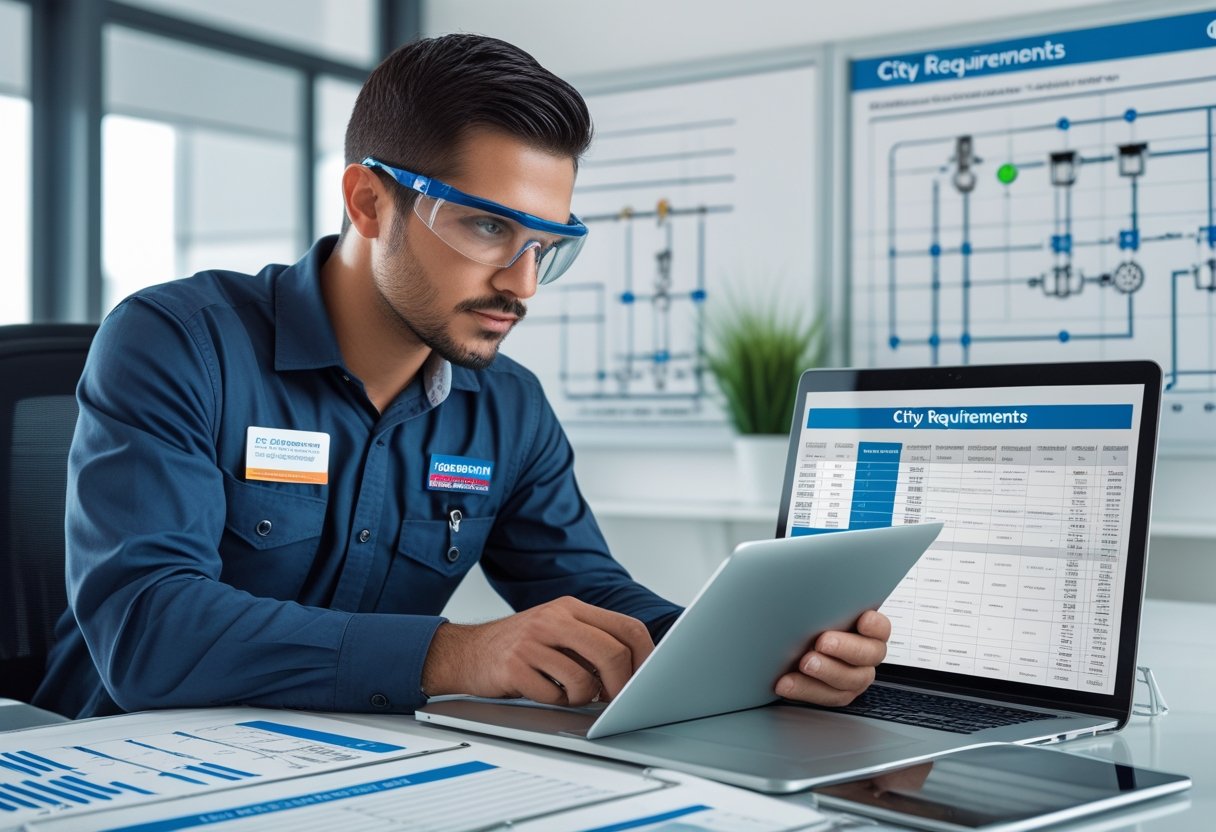Understanding backflow prevention requirements in San Diego is essential for maintaining the safety of your water supply. Complying with local regulations ensures that your property has the necessary backflow prevention devices installed and properly maintained. These measures not only protect your drinking water from contamination, but they also help you avoid potential fines and complications related to non-compliance.
As a property owner, it's your responsibility to stay informed about the necessary backflow testing and installation standards. In San Diego, annual testing is mandated for all backflow prevention devices to guarantee they function effectively. Pacific Backflow offers reliable backflow testing and services to keep your system compliant and your water supply safe.
With nearly five decades of experience in the industry, Pacific Backflow understands the intricacies of local regulations. Rely on our expertise to help you navigate these requirements while ensuring your backflow prevention systems are installed and maintained correctly.
San Diego Backflow Prevention Requirements
Understanding backflow prevention requirements is essential for all property owners in San Diego. These regulations are designed to protect the public water supply from contamination, ensuring the safety and quality of drinking water within the community.
Overview of Local Laws and Codes
In San Diego, backflow prevention is governed by various laws and regulations. The implementation of the Safe Drinking Water Act ensures that public water systems must adhere to strict guidelines. The California Department of Public Health oversees these standards, which require proper cross-connection control measures.
Specific city codes mandate that all 1.5-inch and larger meters for multi-family, commercial, and industrial properties must incorporate backflow prevention assemblies. Regular inspections and testing are necessary to maintain compliance. Failure to follow these regulations can lead to significant legal liabilities and hazards to public health.
Purpose of Backflow Preventers
Backflow preventers are vital devices used to protect potable water supplies from contamination caused by backflow. They operate by preventing the reverse flow of water, which can occur due to changes in pressure in the water system.
By installing backflow preventers, you ensure that harmful pollutants or contaminants do not enter the clean water supply. This not only protects public health but also maintains the integrity of the water distribution system. Utilizing services like those offered by Pacific Backflow can help guarantee that your backflow devices are up to code and functioning properly.
Who Must Comply
Compliance is mandatory for all property owners who have irrigation systems, pools, or other potential cross-connection sources. Residential, commercial, and industrial properties are all subject to the backflow prevention regulations set forth by local authorities.
Property owners are responsible for ensuring their backflow devices are properly tested and maintained. Regular assessments must be conducted annually, and any repairs or installations must meet the guidelines established by the California Department of Public Health. Keeping your systems compliant is crucial for avoiding potential fines and health risks.
Consequences of Non-Compliance
Failing to comply with backflow prevention requirements can result in severe consequences. First and foremost, non-compliance can pose serious public health risks due to the potential contamination of drinking water supplies.
Additionally, property owners may face hefty fines and legal action from local authorities. Immediate corrective action, such as scheduling an inspection or testing with experts from Pacific Backflow, is essential if your system is found to be non-compliant. Neglecting these requirements can lead to costly repairs and damage to your reputation within the community.
Key Backflow Prevention Devices and Assemblies
Understanding the essential backflow prevention devices and their installation requirements is crucial for safeguarding your drinking water supply. This section discusses the main types of approved devices, the necessary installation standards, proper placement, and above-ground installation requirements.
Types of Approved Devices
In San Diego, several backflow prevention devices are widely accepted to protect water supplies. These include:
- Atmospheric Vacuum Breakers (AVB): Used primarily in irrigation systems, they prevent backflow by allowing air into the system during a drop in pressure.
- Pressure Vacuum Breakers (PVB): These are effective in situations where backpressure can occur and are commonly used in various irrigation setups.
- Reduced Pressure Zone (RPZ) Assemblies: Recommended for high-risk applications, these devices feature two independent check valves and a relief valve, providing the highest level of protection.
Selecting the right backflow assembly is essential. Ensure your irrigation meters and water meters have devices appropriate for your specific application to maintain compliance with local regulations.
Installation Standards
Installation standards for backflow prevention devices in San Diego are strict and adhere to both local codes and industry practices. All installations must follow guidelines established by local authorities, ensuring compliance with the California Code of Regulations.
Key standards include:
- Certification: Technicians must be certified for backflow assembly installation.
- Testing: After installation, backflow devices must undergo testing to confirm they are functioning correctly and meet safety standards.
- Documentation: Keeping accurate records of installations and tests is essential for compliance and future maintenance.
By adhering to these installation standards, you protect your water supply and avoid potential fines.
Proper Device Placement
Effective functioning of backflow prevention devices relies heavily on their proper placement. Adhering to clear guidelines ensures optimal performance. Key considerations include:
- Height: Devices should be installed at least 12 inches above horizontal piping to prevent siphon action.
- Accessibility: Ensure sufficient space around the device for testing and maintenance without any obstructions.
- Distance from Contaminants: Install backflow preventers away from potential contaminant sources, such as chemical storage areas, to protect drinking water.
Following these placement guidelines is crucial for maintaining proper operation and compliance with regulations.
Above Ground Installation Requirements
When installing backflow prevention assemblies above ground, specific requirements must be met to ensure effectiveness. These requirements include:
- Weather Protection: Devices should be protected from the elements to prevent freeze damage. Custom-fitted cages can enhance this protection.
- Support Structures: Ensure that the installation is stable and securely mounted to withstand environmental stresses.
- Drainage: Proper drainage around the backflow device is essential to prevent water pooling, which can cause malfunctions.
By adhering to these above-ground installation requirements, you contribute to the longevity of your backflow prevention systems and protect your water supply reliably.
For help with backflow testing, repairs, and installations, consider reaching out to Pacific Backflow for expert assistance tailored to your needs.
Cross-Connection Control Programs in San Diego
In San Diego, cross-connection control programs are crucial for maintaining the safety and integrity of public water systems. These programs focus on preventing contaminants from entering the potable water supply by managing potential cross-connections in plumbing systems. Understanding the roles of different entities and processes involved is essential for ensuring compliance and protecting public health.
Role of the Public Utilities Department
The Public Utilities Department of San Diego is pivotal in implementing the cross-connection control program. It develops regulations to identify and manage cross-connections, ensuring that backflow prevention measures meet local and state codes. Their responsibilities include conducting inspections, overseeing installations, and enforcing compliance with the American Water Works Association standards.
As a water purveyor, the department also ensures that property owners are informed about their responsibilities in maintaining backflow prevention devices. They provide resources and guidelines to help the community adhere to safety regulations.
Program History and Evolution
The cross-connection control program in San Diego has evolved significantly over the years. Initially, it was reactive, addressing backflow incidents as they occurred. However, as public awareness increased and regulations tightened, the program shifted towards a proactive approach.
This includes regular inspections and annual testing requirements for backflow prevention devices, ensuring they function correctly to fend off contaminants. The program is now supported by various organizations like the American Backflow Prevention Association, enhancing its effectiveness through education and advocacy.
Notification and Permitting Process
When installing or modifying backflow prevention devices, the notification and permitting process is critical. Property owners must submit a notification form to the Public Utilities Department before initiating installations. This form requires details about the property, the types of equipment being installed, and the reasons for the installation.
Once submitted, the department reviews and issues permits, ensuring the proposed systems comply with safety regulations. For installations, it's advisable to work with experienced service providers like Pacific Backflow, who understand the local codes and can facilitate a smooth process. Proper compliance helps in maintaining safe water systems throughout San Diego.
Testing, Maintenance, and Certification
Regular testing, maintenance, and certification of backflow prevention systems are vital for protecting San Diego's water supply. Understanding the specific requirements and processes can help you ensure compliance and safeguard your property's plumbing system.
Annual Testing Requirements
In San Diego, annual testing of backflow prevention devices is mandatory. This requirement protects the public water system from potential contaminants. You must have your backflow device tested each year by a certified professional. Failure to comply may result in fines or water service interruptions.
Testing includes inspecting your device for functionality and adherence to city standards. Certified technicians will complete this process efficiently, ensuring that all components are working correctly. In towns like San Diego, many service providers can assist, including Pacific Backflow, known for its reliable and responsive testing services.
Hiring Certified Backflow Testers
When selecting a tester, ensure they have proper certifications from recognized organizations like the American Water Works Association or the American Backflow Prevention Association. Certified testers possess the expertise necessary to identify any issues with your backflow prevention assembly.
Choosing a certified backflow tester helps ensure compliance with local regulations. Their knowledge not only improves the performance of your device but also guarantees that any repairs or maintenance are performed correctly. Always ask for proof of certification before hiring a tester.
Record-Keeping and Reporting
Maintaining accurate records of testing, maintenance, and repairs is essential. You should retain documentation of all tests performed on your backflow prevention devices. These records serve as proof of compliance and may be requested by local authorities.
Your chosen service provider, like Pacific Backflow, often takes care of reporting. They file necessary documents with the city’s water authority, confirming that your backflow device has been adequately tested. Keeping organized records allows you to stay informed about your system's status and compliance requirements.
Approved Tester Lists
San Diego maintains an approved list of certified testers who are qualified to conduct backflow testing. This list ensures that only experienced professionals handle testing and maintenance. You can obtain this list from the city's water department or official website.
By hiring from the approved tester list, you can be confident that the individual conducting the test has met the necessary credentials. This compliance protects your water supply and helps maintain the integrity of your plumbing system. Always confirm that your tester is on the approved list to avoid any regulatory issues.
Special Considerations for Property Owners
As a property owner in San Diego, understanding the specifics of backflow prevention requirements is crucial. These requirements vary based on property type, impacting how you need to manage water systems effectively. Below are key points that highlight the unique considerations for different property categories.
Requirements for Multi-Family and Commercial Properties
For multi-family and commercial properties, backflow prevention is mandatory. Any property with a water meter of 1.5 inches or larger must have a backflow prevention assembly installed at each meter. This assembly protects the drinking water supply from contamination.
Installing and maintaining these devices requires compliance with local regulations. Regular backflow testing is vital, with tests typically performed annually. Failure to comply can result in fines or penalties. To ensure compliance, you can rely on services like those provided by Pacific Backflow, which include hassle-free testing and reporting.
Irrigation Systems and Fire Protection
Irrigation systems and fire protection measures also necessitate backflow prevention devices. These systems can inadvertently introduce contaminants into the water supply if not properly managed.
For irrigation meters, installing a backflow preventer is essential to safeguard drinking water from pollutants. Similarly, fire protection systems need a dedicated backflow assembly to prevent reverse flow during pressure changes. Ensuring your irrigation and fire systems are compliant with these standards will protect community health and meet regulatory demands.
Residential Properties and Exceptions
While residential properties typically face fewer requirements, there are still important regulations to follow. Backflow preventers are generally required for irrigation systems, especially those using potable water.
Homeowners should be aware of any existing devices and ensure they are functioning properly. Regular inspection and testing can help mitigate risk. Some exceptions may apply depending on system size and usage. Engaging with services like Pacific Backflow guarantees that your home meets safety standards, ensuring both compliance and peace of mind regarding your drinking water safety.
Frequently Asked Questions
Understanding backflow prevention requirements is essential for maintaining the safety of the water supply in San Diego. Here are some frequently asked questions that address the key aspects of backflow prevention regulations, testing, certification, and installation.
What are the city's regulations for installing residential backflow prevention devices in San Diego?
San Diego requires that residential backflow prevention devices be installed as a safeguard against contamination. The city’s regulations specify that all properties with irrigation systems or where the water supply could be susceptible to backflow must be equipped with these devices. This ensures that unapproved substances do not enter the public water system.
How often is backflow testing required in San Diego, CA?
Annual testing of backflow prevention assemblies is mandated in San Diego. You must schedule this testing to ensure that the devices function correctly and comply with local regulations. Regular checks help in maintaining the integrity of the water supply.
What is the process for obtaining backflow certification in San Diego?
To obtain backflow certification in San Diego, you will need to complete a training program recognized by the relevant authorities, such as the American Backflow Prevention Association. Certification involves passing a written exam and practical assessment, demonstrating your understanding of backflow prevention principles and practices.
Can you list the backflow preventers approved by the City of San Diego?
The City of San Diego has a list of approved backflow preventers that meet local safety and regulatory standards. These approved devices vary based on the specific requirements of the property and its water usage. It's essential to consult the city's guidelines or a qualified service provider to select the appropriate device for your needs.
What are the costs associated with backflow testing in San Diego?
The cost of backflow testing in San Diego can vary based on several factors, including the device type and the service provider. Typically, you can expect to pay for the test itself, as well as any necessary repairs if the device is found to be malfunctioning. Pacific Backflow offers competitively priced testing services to ensure compliance and safety.
What specific locations require the installation of backflow prevention devices according to San Diego guidelines?
According to San Diego guidelines, backflow prevention devices are required at various locations, including residential properties with irrigation systems, commercial establishments, and any areas where there is a risk of contaminants entering the water supply. Understanding these requirements is crucial to ensuring your property meets local safety regulations.










